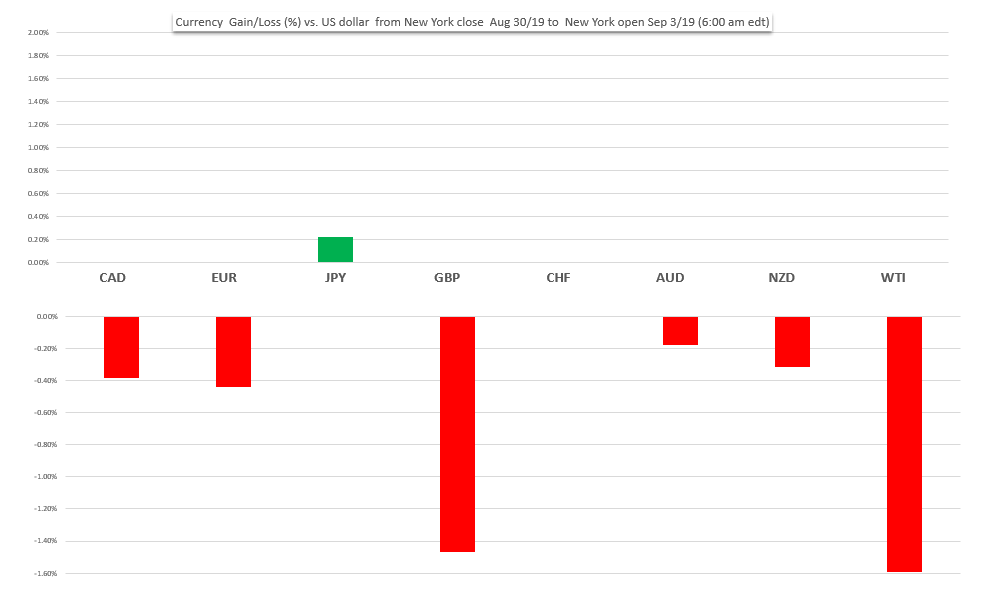
September 3, 2019
USDCAD Open (6:00 am EDT) 1.3361-64 Range (NY close Aug.30-Sep 3,8:30 am EDT) 1.3311-1.3378
The Canadian dollar is collateral damage as the US dollar climbs on broad-based demand. USDCAD blasted above the August cap of 1.3340 following a wave of risk aversion demand for the greenback. The new tariff regime imposed by China and the US on imports that came into effect Sunday set the tone and UK politics turned up the volume.
FX Market Snapshot
Change in Currency value vs the US dollar- NY close Aug.30/19 to NY open Sep.3/19

Traders are concerned that the new tariffs mean the trade war is further entrenche. The two sides cannot even agree on a schedule for new negotiations. Oil traders were spooked. WTI Oil prices started to slide, and then the slide accelerated after Opec announced August crude production rose thanks to increased Iraq and Nigeria supply.
The combination of broad US dollar demand, and falling crude prices turned USDCAD technicals bullish and opened the door to a retest of 1.3660. Wednesday’s Bank of Canada policy statement may exacerbate the rally if the statement is dovish.
Cable snapped. Sterling was the biggest loser against the US dollar compared to Friday’s close. GBPUSD plunged from 1.2166 to 1.1960 when UK Prime Minister hinted that he would call an election for October 14. He expects to win a majority and force the European Union to renegotiate Theresa May’s Brexit deal. If not, it’s bye, bye EU on October 31. Opposition MP’s are scrambling to cobble together a bill that would delay Brexit and thwart Mr Johnson’s plans. GBPUSD recouped some of Monday’s losses and is trading at 1.2021 in New York.
EURUSD was weighed down by GBPUSD selling, mixed euro-area economic data and expectations for new monetary policy stimulus being announced at the September 12 European Central Bank (ECB) meeting. EURUSD slipped to 1.0930 from 1.0990 at Friday’s close.
The Reserve Bank of Australia (RBA) left interest rates unchanged, which was widely expected. They previously cut rates in June and July and are content to continue their evaluation of the impact. The statement said “Looking forward, growth in Australia is expected to strengthen gradually to be around trend over the next couple of years. The outlook is being supported by the low level of interest rates, recent tax cuts, ongoing spending on infrastructure, signs of stabilisation in some established housing markets and a brighter outlook for the resources sector.”
USDJPY drifted lower in a 105.93-106.37 range but recouped most of the losses in early New York trading. Selling was sparked by safe-haven demand for yen and US 2-yr/10-yr yield curve inversion. US 10-year yields climbed help lift USDJPY to 106.24 in early New York trading.
US ISM Manufacturing and Construction spending reports are on tap today. There are not any Canadian economic data releases of note.
The intraday USDCAD technicals are bullish. The break above 1.3340 cracked a “triple-top” and opened the door to further gains to 1.3660 as long as prices are above 1.3270, the uptrend line from the middle of July. For today, USDCAD support is at 1.3330, 1.3310 and 1.3280. Resistance is at and 1.3230. Resistance is at 1.3390 and 1.3430.
Today’s Range 1.3340-1.3420






